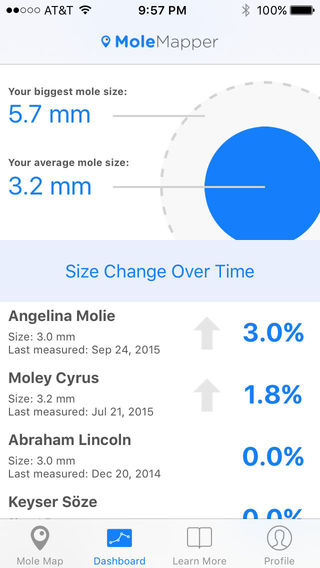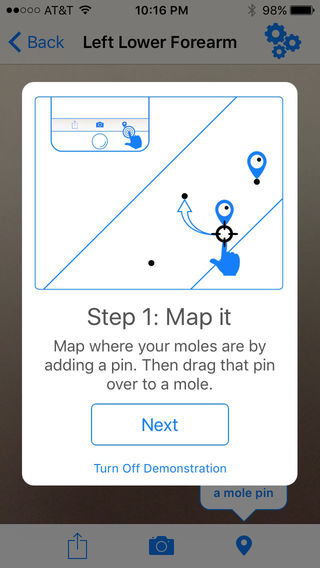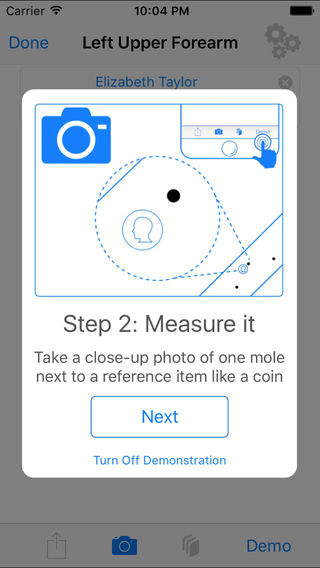Mole Mapper iPhone-app Based Research Study to Better Understand Melanoma Launched
 Sage Bionetworks, a nonprofit biomedical research organization, together with Oregon Health and Science University and collaborator Dan Webster, PhD, a cancer biologist at the National Cancer Institute and founder and lead developer of MoleMapper.org, have announced the launch of Apple ResearchKit developed Mole Mapper, a patient-centered iPhone-app based study to quantitatively track moles and help detect early signs of the deadly skin cancer melanoma.
Sage Bionetworks, a nonprofit biomedical research organization, together with Oregon Health and Science University and collaborator Dan Webster, PhD, a cancer biologist at the National Cancer Institute and founder and lead developer of MoleMapper.org, have announced the launch of Apple ResearchKit developed Mole Mapper, a patient-centered iPhone-app based study to quantitatively track moles and help detect early signs of the deadly skin cancer melanoma.
Mole Mapper is free and available to download immediately from the App Store. Using the iPhone’s camera and an Apple Maps-like interface, Mole Mapper will enable participants to track the appearance, size, shape, and location of their moles to help catch early signs of melanoma. Participants can choose to share their own Mole Mapper information with their physicians and de-identified images and mole data will provide researchers with the tools to answer basic questions about how melanoma develops.
The Mole Mapper study is sponsored by Stephen Friend, MD, PhD, president of Sage Bionetworks, and Sancy Leachman, MD, PhD, professor and chair of the dermatology department at the Oregon Health Sciences University (OHSU) and director of the melanoma research program at the Knight Cancer Institute sponsored the research arm of Mole Mapper.
“Melanoma is the poster child for early detection. If we can identify melanomas earlier by creating a simple way for patients to share images of their moles we can learn more about the progression of the disease,” says Dr. Leachman. “Expanding our pool of research participants is a critical step in gaining the information we need. ResearchKit makes this easier than ever with the development of a simple iPhone app.”
Melanoma is one of the most dangerous forms of skin cancer, and early detection is key to improving survival. At present, the American Cancer Society estimates that there are more than 135,000 new cases of melanoma detected each year in the United States, though the risk in those over 40 years of age appears to be increasing. Moles, brown spots and skin growths are usually harmless, however people with over 100 moles are at increased risk of developing melanoma.
 Mole Mapper is an app-based tool to allow people to track their moles with photographs for their own records and to share with others to detect changes over time. Through the ResearchKit framework, users of Mole Mapper can now donate their images and some basic health information to drive future research on early detection of melanomas.
Mole Mapper is an app-based tool to allow people to track their moles with photographs for their own records and to share with others to detect changes over time. Through the ResearchKit framework, users of Mole Mapper can now donate their images and some basic health information to drive future research on early detection of melanomas.
Sage brought together OHSU, a leader in melanoma research at the forefront of educating patients about current research and educational opportunities focused on early detection, prevention and survivorship through its War on Melanoma Community Registry, and Dr. Webster, who originally conceived Mole Mapper as a way for users to keep track of moles between visits to the dermatologist. Webster, then a novice programmer, developed the first version of the Mole Mapper app while completing his PhD at Stanford University and conducting basic research on melanoma biology.
“My wife has a variety of risk factors for developing melanoma, and we would keep track of her moles by taking pictures,” xplains Dr. Webster. “I thought, there should be an app for this.” He describes the years that followed as a lot of genome engineering by day and software engineering by night. Beginning in late 2014, working with Sage and then OHSU, Webster has transformed the app into a research study to help answer pivotal questions about melanoma risk and development.
“One of the most important melanoma risk factors is how a mole is evolving over time, but nobody really measures that in a quantitative way,” says Dr. Webster. “Using Mole Mapper we’re attempting to understand when a mole is watch-and-wait and when it requires the attention of a dermatologist, and to understand the basics of how moles change as a proxy for increased risk of melanoma. Until now, there wasnt large, systematic study that asks how much change is dangerous, or whether that change matters more or less depending on where a mole is located on the body.”
The launch of the Mole Mapper research study builds on the success of Sage’s previously announced app-based research studies Parkinson mPower and Share the Journey. Those studies, with the participation of more than 20,000, began in March 2015 to investigate symptom variation in Parkinsons disease and improve the quality of life for women who have been treated for breast cancer.
 Apps Enabled By Sage’s Open-Source Platforms
Apps Enabled By Sage’s Open-Source Platforms
Like mPower and Share the Journey, the Mole Mapper study is underpinned by Sage’s web-based, open-source Bridge research platform. Bridge enables the design and recruitment of large, dynamic, and collaborative mobile app-based research studies, and facilitates making the results of that research available for further analysis. Sage has made Bridge available to researchers worldwide who, together with research participants, can create the kind of highly relevant datasets on individuals and their environments that are missing from traditional research. Bridge is supported by funding from the Robert Wood Johnson Foundation and The Leona M. and Harry B. Helmsley Charitable Trust.
“Sage’s platforms continue to empower researchers like Dan Webster to pursue interesting questions at the intersection of mobile technology and basic research in a way that can be meaningful and important,” says Andrew Trister, MD, PhD, senior physician at Sage Bionetworks. By putting individuals experiences at the center of the research process, researchers working in virtual teams can efficiently and inexpensively tap into high-quality data streams.
Mole Mapper also further validates Sage’s Participant-Centered Consent platform, a first-of-its-kind, institutional review board-approved interactive process for electronically gaining informed consent from research participants. This e-consent process is a unique, robust, and ethical way to recruit participants into low-risk research studies.
 Researchers and developers using the open source software framework continue to contribute to ResearchKit with new modules, active tasks and custom surveys. The Active Task module enables researchers to gather more targeted data for their study by inviting participants to perform activities that generate data using iPhones advanced sensors. Initial Active Task modules included tasks to measure motor activities, fitness, cognition and voice.
Researchers and developers using the open source software framework continue to contribute to ResearchKit with new modules, active tasks and custom surveys. The Active Task module enables researchers to gather more targeted data for their study by inviting participants to perform activities that generate data using iPhones advanced sensors. Initial Active Task modules included tasks to measure motor activities, fitness, cognition and voice.
In just six months, more than 50 researchers have contributed active tasks to support new methods of research, including tasks to study tone audiometry for hearing loss; the ability to measure reaction time through delivery of a known stimulus to a known response; a timed walk test; PSAT to assess the speed of information processing and working memory, and the mathematical puzzle Tower of Hanoi often used for cognition studies. Additional contributions to the ResearchKit framework include iPad support, image capture and the ability to add pie charts, line graphs and discrete graphs for more detailed dashboards.
For more information, visit:
http://www.sagebase.org
Source: Sage Bionetworks
